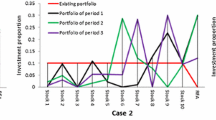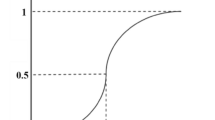Abstract
In the ever changing financial markets, investor’s decision behaviors may change from time to time. In this paper, we consider the effect of investor’s different decision behaviors on portfolio selection in fuzzy environment. We present a possibilistic mean-semivariance model for fuzzy portfolio selection by considering some real investment features including proportional transaction cost, fixed transaction cost, cardinality constraint, investment threshold constraints, decision dependency constraints and minimum transaction lots. To describe investor’s different decision behaviors, we characterize the return rates on securities by LR fuzzy numbers with different shape parameters in the left- and right-hand reference functions. Then, we design a novel hybrid differential evolution algorithm to solve the proposed model. Finally, we provide a numerical example to illustrate the application of our model and the effectiveness of the designed algorithm.

Similar content being viewed by others
References
Angelelli, E., Mansini, R., & Speranza, M. G. (2008). A comparison of MAD and CVaR with real features. Journal of Banking and Finance, 32(7), 1188–1197.
Brest, J., Greiner, S., Bošković, B., Mernik, M., & Zumer, V. (2006). Self-adapting control parameters in differential evolution: A comparative study on numerical benchmark problems. IEEE Transactions on Evolutionary Computation, 10(6), 646–657.
Cadenas, J. M., Carrillo, J. V., Garrido, M. C., Ivorra, C., & Liern, V. (2012). Exact and heuristic procedures for solving the fuzzy portfolio selection problem. Fuzzy Optimization and Decision Making, 11(1), 29–46.
Carlsson, C., & Fullér, R. (2001). On possibilistic mean value and variance of fuzzy numbers. Fuzzy Sets and Systems, 122(2), 315–326.
Das, S., & Suganthan, P. N. (2011). Differential evolution: A survey of the state of the-art. IEEE Transactions on Evolutionary Computation, 15(1), 4–31.
Dubios, D., & Prade, H. (1980). Fuzzy sets and system: Theory and application. New York: Academic Press.
Gupta, P., Inuiguchi, M., Mehlawat, M. K., & Mittal, G. (2013). Multiobjective credibilistic portfolio selection model with fuzzy chance-constraints. Information Sciences, 229, 1–17.
Jiang, Z. Z., Fan, Z. P., Ip, W. H., & Chen, X. H. (2016). Fuzzy multi-objective modeling and optimization for one-shot multi-attribute exchanges with indivisible demand. IEEE Transactions on Fuzzy Systems, 24(3), 708–723.
Kocadaǧlı, O., & Keskin, R. (2015). A novel portfolio selection model based on fuzzy goal programming with different importance and priorities. Expert Systems with Applications, 42(20), 6898–6912.
Konno, H., & Wijayanayake, A. (2001). Portfolio optimization problem under concave transaction costs and minimal transaction unit constraints. Mathematical Programming, 89(2), 233–250.
Li, D., & Peter, S. (2011). A portfolio selection model using fuzzy returns. Fuzzy Optimization and Decision Making, 10(2), 167–191.
Lin, Y. C., Hwang, K. S., & Wang, F. S. (2004). A mixed-coding scheme of evolutionary algorithms to solve mixed-integer nonlinear programming problems. Computers & Mathematics with Applications, 47(8/9), 1295–1307.
Mansini, R., & Speranza, M. G. (1999). Heuristic algorithms for the portfolio selection problem with minimum transaction lots. European Journal of Operational Research, 114(2), 219–233.
Markowitz, H. M. (1952). Portfolio selection. Journal of Finance, 7(1), 77–91.
Mohamed, A. W., & Sabry, H. Z. (2012). Constrained optimization based on modified differential evolution algorithm. Information Sciences, 194, 171–208.
Speranza, M. G. (1993). Linear programming model for portfolio optimization. Finance, 14, 107–123.
Storn, R., & Price, K. (1995). Differential evolution-a simple and efficient adaptive scheme for global optimization over continuous spaces. Technical Report TR-95-012, International Computer Science Institute, Berkeley, CA.
Storn, R., & Price, K. (1997). Differential evolution—A simple and efficient heuristic for global optimization over continuous spaces. Journal of Global Optimization, 11(4), 341–359.
Tsaur, R. C. (2013). Fuzzy portfolio model with different investor risk attitudes. European Journal of Operational Research, 227(2), 385–390.
Vernic, R. (2016). Optimal investment with a constraint on ruin for a fuzzy discrete-time insurance risk model. Fuzzy Optimization and Decision Making, 15(2), 195–217.
Wang, S., & Zhu, S. (2002). On fuzzy portfolio selection problems. Fuzzy Optimization and Decision Making, 1(4), 361–377.
Xidonas, P., Mavrotas, G., Zopounidis, C., & Psarras, J. (2011). IPSSIS: An integrated multicriteria decision support system for equity portfolio construction and selection. European Journal of Operational Research, 210(2), 398–409.
Yang, S. C., Lin, T. L., Chang, T. J., & Chang, K. J. (2011). A semi-variance portfolio selection model for military investment assets. Expert Systems with Applications, 38(3), 2292–2301.
Zhang, W. G., Liu, Y. J., & Xu, W. J. (2012). A possibilistic mean-semivariance-entropy model for multi-period portfolio selection with transaction costs. European Journal of Operational Research, 222(2), 341–349.
Zhang, W. G., Zhang, X. L., & Xu, W. J. (2010). A risk tolerance model for portfolio adjusting problem with transaction costs based on possibilistic moments. Insurance: Mathematics and Economics, 46(3), 493–499.
Acknowledgements
This research was supported by the National Natural Science Foundation of China (Nos. 71501076 and 71720107002), the Natural Science Foundation of Guangdong Province of China (Nos. 2014A030310454 and 2017A030312001), the Fundamental Research Funds for the Central Universities (No. 2017ZD102) and Guangzhou Financial Services Innovation and Risk Management Research Base.
Author information
Authors and Affiliations
Corresponding author
Rights and permissions
About this article
Cite this article
Liu, YJ., Zhang, WG. Fuzzy portfolio selection model with real features and different decision behaviors. Fuzzy Optim Decis Making 17, 317–336 (2018). https://doi.org/10.1007/s10700-017-9274-z
Published:
Issue Date:
DOI: https://doi.org/10.1007/s10700-017-9274-z




